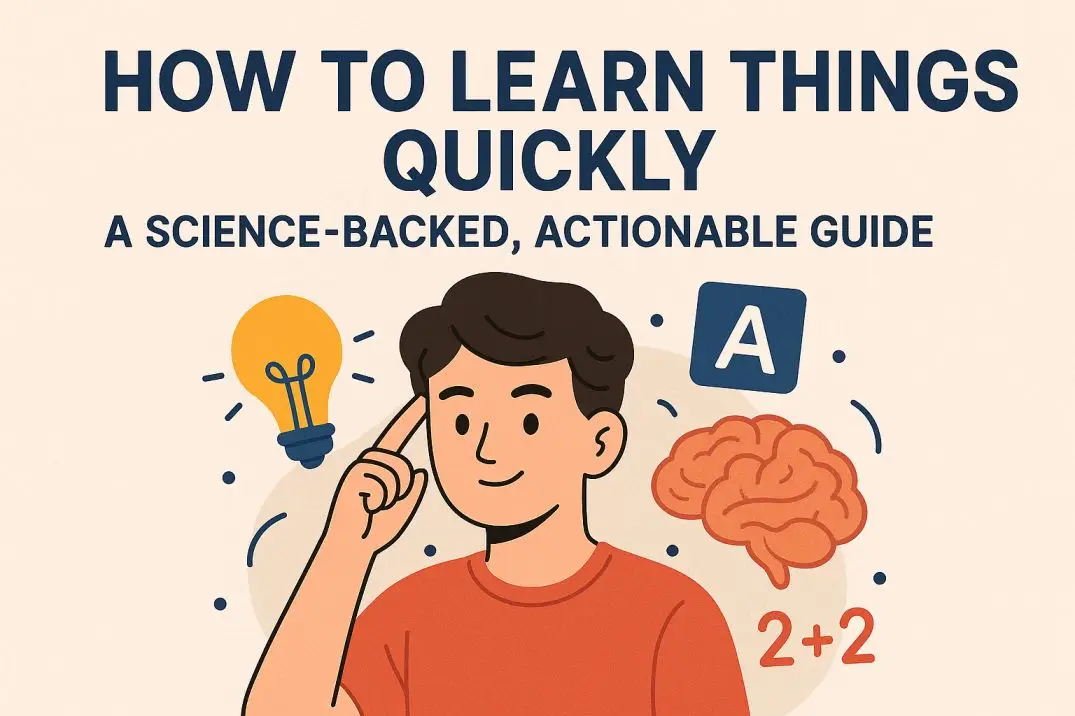In a world where information is abundant and time is limited, the ability to learn things quickly is more valuable than ever. Whether you’re picking up a new language, mastering a software tool, or diving into a complex subject, the speed at which you learn can significantly impact your success. But how can you accelerate your learning process without sacrificing depth or retention?
This guide explores research-backed strategies and practical techniques to help you learn more efficiently and effectively.
🧠 The Science of Fast Learning
Before diving into specific techniques, it’s essential to understand the cognitive principles that underpin rapid learning.
1. Active Recall
Active recall involves actively stimulating memory during the learning process. Instead of passively rereading notes, you test yourself on the material. This method has been shown to enhance long-term retention and understanding .
2. Spaced Repetition
Spaced repetition is a learning technique that involves increasing intervals of review over time. Tools like Anki utilize this method to help learners retain information more effectively .
3. Dual Coding
Dual coding combines verbal and visual information to enhance learning. By integrating images with text, you engage multiple cognitive pathways, making the material more memorable .
⚡ Practical Techniques to Learn Faster
Now that we have a foundational understanding, let’s explore actionable strategies to accelerate your learning.
1. Teach What You Learn
One of the most effective ways to solidify knowledge is to teach it to someone else. This approach forces you to clarify your understanding and identify gaps in your knowledge. The “protégé effect” suggests that teaching others can enhance your own learning .
How to Implement:
- Explain concepts to a peer or even an inanimate object.
- Create tutorials or write blog posts about what you’ve learned.
- Engage in discussions or debates on the topic.
2. Use the Feynman Technique
Named after physicist Richard Feynman, this technique involves explaining a concept in simple terms as if teaching a child. This process helps identify areas of confusion and reinforces understanding .
Steps:
- Write down the concept at the top of a page.
- Explain it in simple language, as if teaching someone else.
- Review your explanation, identify gaps, and revisit the source material.
3. Apply the 80/20 Rule
The Pareto Principle, or 80/20 rule, posits that 80% of results come from 20% of efforts. Identify the most critical aspects of what you’re learning and focus your energy there.
Application:
- Prioritize core concepts that will yield the most significant impact.
- Eliminate or minimize time spent on less critical details.
4. Embrace Desirable Difficulty
Introducing manageable challenges during learning can improve long-term retention. Techniques like interleaving (mixing different topics) and varying practice conditions can enhance learning by making it more effortful and engaging .
How to Apply:
- Mix different subjects or skills during study sessions.
- Practice under varied conditions to improve adaptability.
5. Optimize Your Environment
Your physical and mental environment plays a crucial role in learning efficiency.
Strategies:
- Minimize distractions by creating a dedicated study space.
- Use tools like the Pomodoro Technique to maintain focus.
- Ensure adequate lighting and comfort to enhance concentration.
6. Incorporate Movement
Physical activity can boost cognitive function and memory retention. Short bursts of exercise during study sessions can enhance learning .
Implementation:
- Take short walks during breaks.
- Engage in light stretching or yoga before study sessions.
7. Prioritize Sleep and Nutrition
Adequate rest and proper nutrition are vital for cognitive function and memory consolidation. Ensure you’re getting sufficient sleep and maintaining a balanced diet to support your learning efforts .
Tips:
- Aim for 7-9 hours of sleep per night.
- Eat brain-boosting foods rich in omega-3 fatty acids and antioxidants.
📊 Learning Strategies Comparison
| Technique | Benefits | Best For |
|---|---|---|
| Active Recall | Enhances long-term retention | All learners |
| Spaced Repetition | Improves memory consolidation | Language learners |
| Dual Coding | Engages multiple cognitive pathways | Visual learners |
| Teach What You Learn | Reinforces understanding | Complex subjects |
| Feynman Technique | Identifies knowledge gaps | Conceptual clarity |
| 80/20 Rule | Maximizes efficiency | Time-constrained learners |
| Desirable Difficulty | Enhances adaptability and retention | Advanced learners |
| Movement | Boosts cognitive function | All learners |
| Sleep & Nutrition | Supports overall brain health | All learners |
🧭 Final Thoughts
Learning things quickly isn’t about cutting corners; it’s about working smarter, not harder. By understanding and applying these research-backed strategies, you can accelerate your learning process without compromising depth or retention.
Remember, the key is consistency and deliberate practice. Implement these techniques, monitor your progress, and adjust as needed to find what works best for you.
💬 Call to Action
Have you tried any of these techniques? Share your experiences in the comments below. If you’re interested in personalized learning plans or further resources, feel free to reach out. Let’s embark on this learning journey together!

